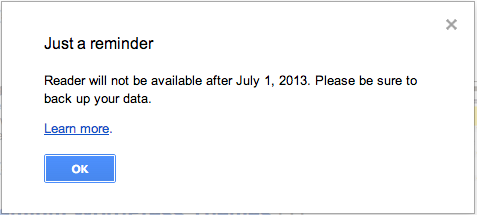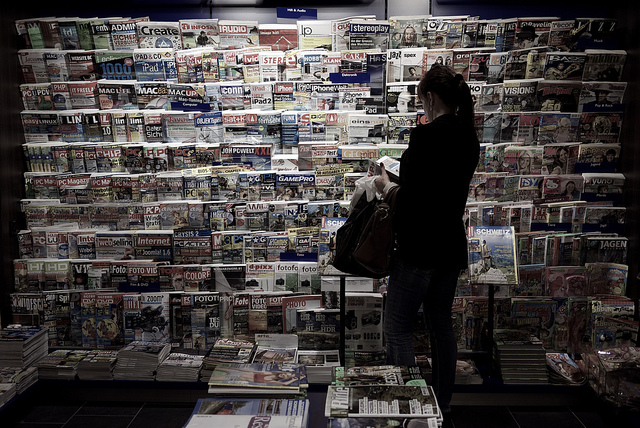You’re blog doesn’t have subscribers. You might think it does. You might see some traffic trickle in from your Feedburner account. When people tell you they “read your blog,” it might make you think they are one of your beloved subscribers. But they’re not. You don’t have blog subscribers.
When I first started “blogging” back in 2009, all the blogging gurus told us that our number one goal should be getting subscribers. They touted their Feedburner subscriber count with a tiny “Feedburner chicklet” showing thousands and told us that “subscribers” was the magic measurement of success. “Focus on RSS subscribers!” they would tell us.
Well, guess what? Those days are over. Google just killed Google Reader, the #1 way to “subscribe” to blogs using RSS feeds. Most agree, that Feedburner is next on the chopping block.
They know something most of us are afraid to admit: there is no such thing as blog subscribers.
At least not anymore . . .
Subscriptions in Days of Old
Newspapers
For a few decades, our dads would walk outside in a bathrobe every morning and pick up the morning copy of the newspaper. He was a subscriber. He paid for a subscription and every day he read the paper to see what was happening in the world and his local community today (well, yesterday).
Newspapers are dying because we’re not subscribers anymore. I don’t mean we don’t subscribe, I mean in the way that we relate to content, we no longer function as subscribers. Subscribers no longer exist with the online world.
Magazines
If you subscribe to a magazine, it arrives in your mailbox once or twice a month. After searching through the ads to find an actual article, you read and consume the information. You are a subscriber.
But many magazines are losing money too. Some, like Newsweek, are going digital-only. Why? Not because it costs so much to print, but because their subscribers evolved. We’ve evolved.
We’re no longer consumers, we’re community-members. And that’s they key.
Newsweek and many other magazine media companies are realizing that the secret to online success isn’t subscriptions, its engagement. Engagement comes by interacting with a community.
Your New Blog Strategy: From Subscriptions to Connections
 Google killed Google Reader because they saw a significant drop in usage (of an admittedly techie crowd) over the last couple of years. Why? Because RSS, though convenient, is no longer the most interesting source of information. We’re not subscribers anymore. We’re members of communities.
Google killed Google Reader because they saw a significant drop in usage (of an admittedly techie crowd) over the last couple of years. Why? Because RSS, though convenient, is no longer the most interesting source of information. We’re not subscribers anymore. We’re members of communities.
Where do most people find content from bloggers they love? The content doesn’t show up on their doorstep. It isn’t received. Its communicated. People find content they need and want through Facebook, Twitter, Google+, Reddit, and all sorts of other social networks. It’s being recommended by people they trust–people like you.
No one wants to subscribe to your blog anymore. They might add your RSS feed to their new Feedly account, but they won’t read it. Not everyday. You’re competing with hundreds of other RSS feeds.
They want connection.
They want to connect with you as a person, not as a media outlet. Post something interesting that helps a community of people. When someone in that community finds your post, reads it, and likes it, they will share it. Then other members of the community will find, read, and share it too.
Everything you write should be a gift to a community. You’re generosity will earn their trust and you will become known in the community.
Here’s the key: blogging or any form of media today is now longer a one-way form of communication. You’re new piece of content is a gift to a community that will want to share their own thoughts and contributions. They will engage with you and with others about what you’ve given them. It’s a conversation that you’ve either started or joined.
You now have a choice: join the conversation by adding value to it or keep “publishing” new blog posts to those imaginary subscribers (consumers) who no longer exist.
Your new goal: connections.
[Sidebar: I do not mean “followers” or “likes” or “fans.” That’s a subscriber mentality. They’re not consumers, they’re a part of a community and so are you. A new “follower” is an opportunity to start a conversation. They are connections.]
Shifting to Blog Connection Era Tactics
In the post-subscriber age, here is how you succeed:
- Identify a specific community with specific voices (bloggers) and the conversations they are already having.
- Write for this community, not yourself. Add to a conversation or start one.
- Create and share evergreen content that is as valuable today as it will be years from now.
- Share content from other bloggers in your community. Do this on your blog or on your social networks. Don’t broadcast, continue the conversation.
- Start an email list. Use email to communicate with people in your community. It’s still the most intimate form of communication on the web today. Technically, it’s here that you could give something on a consistent basis for people to subscribe to.
- Connect with other bloggers by joining or starting a conversation on Twitter, Facebook, Google+, LinkedIn, or their blogs.
- Connect people in the community who don’t know each other yet.
- Become known in your community as THE [blank]. Of all the people and voices in your community, how are you distinguished from the others?
Owning your “THE”
This might be the most crucial shift in the blogging world. There are so many more voices in your community than there were years ago. I know I can’t keep them all straight in my head unless they distinguish themselves with a consistent message, type of content, or approach. They have to repeat it or I won’t remember it. Soon they become “the [something] guy” or “the person who does [such and such].”
Own your “the” by focusing on one message for six months or more. Soon, you’ll be known in your community “the [something] person” and they won’t forget it. It helps to give your [something] a name and repeat it.
By the way, if you want to be an author of a successful book, find your “the” and write a book about it. A book is an excellent way to own your “the.”
Now, go make connections.
P.S. Dear book publishers: stop worrying about the “size” of a potential author’s blog and start asking who they know, who knows them, and what they’re known for (like you used to do in the old days). Ask other authors in a community what a potential author’s “the” is.
P.P.S. Why is podcasting so popular among bloggers these days? Because, at the moment, people subscribe to podcasts. Podcasters have subscribers.
P.P.P.S. How can authors survive the death of Google Reader? I like Caitlin Muir’s post-subscriber ideas.
P(x4). S. Even Seth Godin is hoping I’m wrong. Here he tries to save his subscribers (but to any avail?)
(photo credit: thomasleuthard)




In terms of community sharing and engagement, I think email is the key for bloggers. So much has changed for me since I started emphasizing email subscriptions. It’s much more intimate. People respond to me and tell me directly when they like stuff. It just feels more connected. But, of course, you can’t see other comments and there’s no group interaction that way. It’s awesome one on one, though.